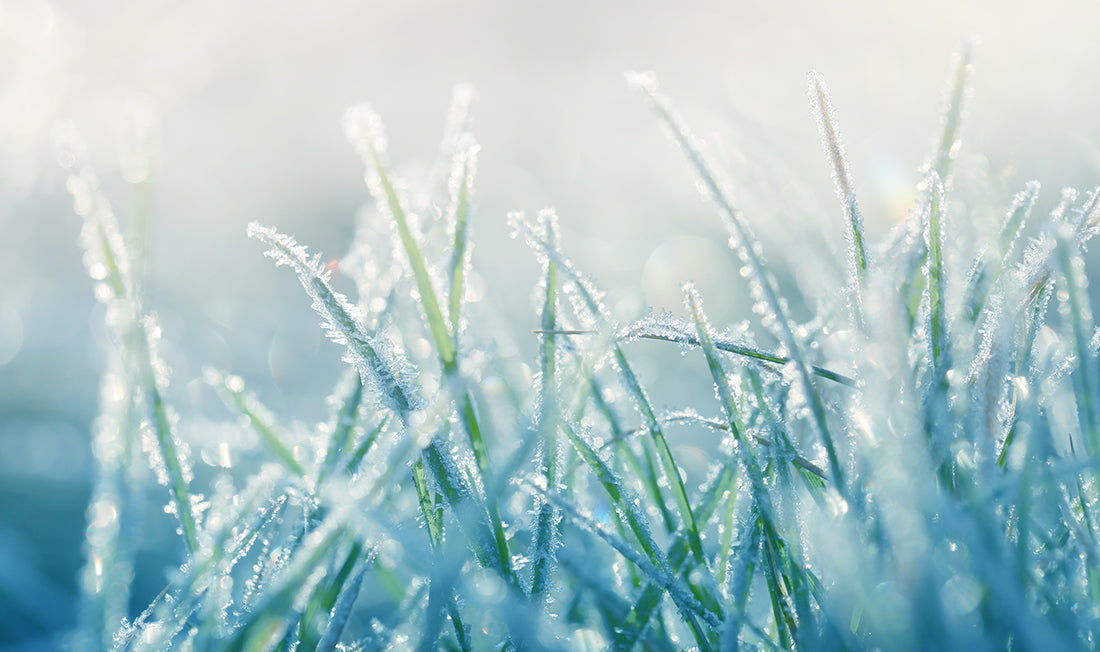Winter can be a tough time on your lawn. Unfortunately, no grass species is immune to sustaining injury during the winter months. Injury can occur from a few different sources. Low temperatures, winter diseases, desiccation of tissue, as well as injury related to ice forming within and around the grass blades that make up your lawn. How much control do you have over preventing ice injury to your lawn? Well, that depends, so read on to find out what you can and can’t do to protect your precious grass from ice damage. Before we can decide whether we can prevent ice damage to our lawns, we have to understand the different ways that ice can cause injury to your turf.
Frost / Frozen Dew - This first one we’re probably all familiar with. We might be less familiar with the specific kinds of frost and how they’re named. Frozen dew occurs when the dewpoint is above freezing and the temperature drops to the dew point allowing dew formation on the grass blades. The temperatures then continue to decline, and the dew eventually freezes on the turf. Frost is what occurs when the dewpoint is actually below zero, and the water vapor in the air bypasses the liquid state and goes straight to the solid state (ice), freezing on the leaf surface of your lawn.

Firstly, warm-season grasses do not take kindly to heavy frosts. The leaves will typically senesce, and depending on the season, the grass will fast track its entrance into dormancy, or its spring green-up can be severely set back. Cool-season grasses, on the other hand, typically put up with frosts pretty well. Seedlings, however, are a different story. Immature seedlings are prone to frost injury.
Intracellular Ice Formation - When ice forms inside the cells of the grass plants in your lawn, bad things can happen. This is commonly referred to as crown hydration. The crown of your grass plant is the center of meristematic activity. This is the mothership, must protect at all costs, center of growth. In order to survive the winter months, the crowns of your grass plant will dehydrate. During the spring, as they begin to start actively growing again, the cells in the crown will become hydrated. This hydration leaves them vulnerable to freezing temperatures common during the early spring months. Ice forming within the cells of the crown can rupture them and cause some serious problems.

Extracellular Ice Formation - This refers to ice forming inside of the plant but not actually within the plant’s cells. This is typically less damaging than the aforementioned intracellular ice. It can still cause damage, though. Ice forming outside of the plant’s cells draws water from within the cell to the intercellular space. If the cells in the crown of the plant experience too much dehydration, injury can occur.
Ice Cover - Depending on your location, this may never become an issue for you. This is when a layer of ice forms like a sheet across the top of your lawn. This can be from snow and sleet or frozen precipitation melting and refreezing. The ice layer becomes an issue if it is allowed to remain in place for an extended period (30-60 days). The main problem is that the ice layer prohibits the exchange of soil gases, so oxygen isn’t diffusing into the soil from the atmosphere, and built-up toxic gases can’t escape the soil to the atmosphere.
Now that we have discussed some of the ways that ice can damage your lawn, let’s think about ways that we could possibly prevent this damage from occurring or at least how we can play damage control.
When it comes to preventing damage from frost-related ice, the best practice is probably just to stay off your lawn until the frost melts. There is a bit of controversy in turfgrass circles about whether walking on frost-covered grass will injure it. Some say it does no harm, but others have photographic evidence of footstep-shaped damage after someone had walked on frost-covered grass. Whether damage will occur does not appear absolute but is likely a more nuanced situation.
When it comes to your lawn, preventing ice formation within the plant is somewhat of a fool’s errand. You could place covers over your lawn to help moderate soil temperatures prior to extreme cold events. That would be quite an undertaking for the average homeowner. You can pray that the cold comes along with a round of snow cover. The snow can act as a blanket insulating your grass. Increasing drainage in low-lying areas can also help prevent crown hydration. Saturated, low-lying areas are commonly where the worst of the crown hydration damage occurs.

Ice cover is an easy one to prevent. Think about the kinds of snow or winter precipitation that have occurred recently. You can also just throw on the snow boots and walk your yard. If you don’t feel a hard layer of ice completely covering large areas of your lawn, then this kind of ice damage is unlikely to occur.
When it comes to preventing ice damage, planting the correct grass for your location, increasing drainage, and just staying off your lawn are all good practices. If your lawn looks a little lackluster this spring, contact us for a free lawn care plan to get you back on the up and up. Or, try our lawn quiz today to find the right products for your specific grass and situation.









